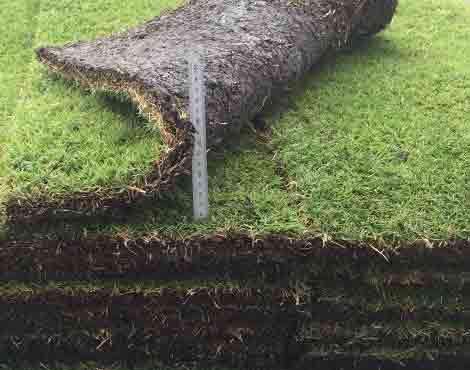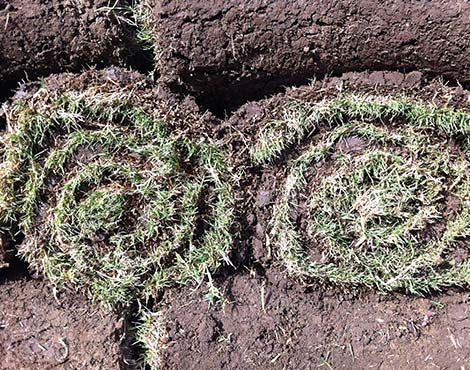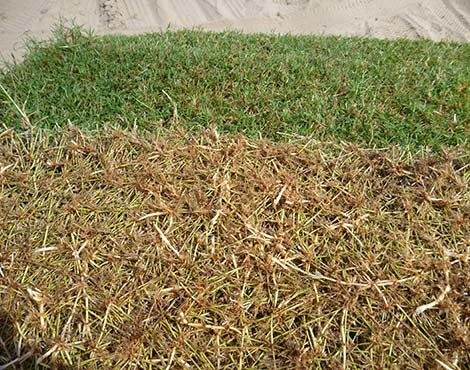Planting methods depend on whether you are laying vegetative turf (sod) or using seed. Most lawns or recreational areas are laid as vegetative turf which provides an instant result and surface protection. Only 8% of new lawns are seeded. Vegetatve turf normally comes in rolled strips (turf rolls) or turf slabs (see images below) that are usually 45 cm to 50 cm wide. If you are purchasing turf from a retailer and not direct from the turf supplier, check to see what size or area of the turf they are selling so you don't fall short. Normally a turf slab does not equate to 1m² e.g. Bunnings turf slabs or rolls are usually only 0.75m².
Be sure you have ordered enough turfgrass for your lawn area. Refer to our turf calculator page for help.
Prepare and level your soil for planting as detailed in our site preparation page. Ideally you would like to have 100 mm to 150 mm of good quality topsoil or turf underlay present. Skimping on the quality and quantity of soil should be avoided as you will encounter long term management issues.
Lay the turf as soon as possible. Ideally, as soon as it arrives on site, or on the day you receive it for best results. Leaving the turf slabs or rolls on a pallet or in a stack allows the turf to heat and even cook. This results in what is called "pallet burn". Significant turf loss (death) can result.
Starting at a straight edge such as a path or driveway, lay the rolled out strips side by side in rows and end to end within each row.
Stagger the joints (as best as possible) in adjoining rows like bricks so not to have the turf joins of adjacent rolls aligned.
Make sure all joints (sides and ends) are butted together tightly without overlapping. This is to stop the turf edges drying out and causing ongoing management issues or a trip hazard. You or your turf installer should not have to fill gaps with sand or soil.
Use a large knife or spade for cutting turf around trees, garden beds and edging.
If you can, roll the turf prior to watering the grass to provide a good turf to soil contact. Using a water filled garden roller or self propelled walk behind roller from a machinery hire place is desirable.
Water the laid turf as you go, starting 15 to 30 minutes after you lay your first turf.
After you have installed and irrigated all of your turf, once again use the roller to smooth out any footprints etc. This will also remove any air pockets and ensures the turf has even better contact with the soil.
Give the whole area a good soaking with about 25 mm for the first watering.
Subsequent rolling can be undertaken post watering to remove any further minor undulations or bumps. Be sure not to use a roller if the soil is too wet e.g. footprints can be seen in the turfgrass.
Although the grass will accept light traffic at this stage, it should not be brought into full service until the turf has firmly rooted. This usually takes around 2 to 4 weeks depending on the species of turfgrass, the time of year and your location. Rooting can be easily checked by lifting a corner of one of the turf slabs or rolls.
It is adventageous to apply a pre-emergent product across your lawn to prevent/limit weeds from germinating. This can be applied once all the turf has been laid and should be applied when the turf foliage is dry.
It is recommended that a turf quality starter fertiliser be applied to the turfgrass to help the lawn establish.
Refer to our after planting care page to see what is required next.
 |
 |
 |
| Turf slabs | Turf rolls | Washed turf |
Refer to our seed page which provides detailed information on specie and variety selection.
If time permits, prepare and water the seed bed prior to sowing. This will encourage the germination of the most undesirable seeds i.e. weeds. Eradicate the emerging seedlings with glyphosate, as per label recommendations, before sowing your desired turf seed.
Take care to spread the seed evenly over the area during planting. Except for kikuyu and buffalograss, seed of most warm-season turfgrasses (green and blue couch, centipede grass, zoysia) is quite small.
Seeding rates for these warm-season turfgrasses are usually between 0.5 and 1 kilogram per 100 square metres. Refer to instructions on the packet for specific information.
Mix the seed with moistened ‘brickies’ sand before planting to help in spreading it evenly. For best results, use five parts of moist sand to one part of seed.
Spread the seed in at least two applications across the area, the second crisscrossing the first at right angles to it.
After seeding, rake the area lightly, covering the seed with no more than about 2-3 mm of soil.
Seed germination is more rapid if you water the planting area immediately after planting and keep it moist, but not wet, by shallow watering during germination. Do not overwater, as this could wash the seed away.
Do not apply a pre-emergent to the soil. This will stop germinating weeds, but it will also stop your seed from germinating.
Apply a turf starter fertiliser once your seed has germinated to assist leaf, runner and/or rhizome development.
Refer to our after planting care page to see what is required next.